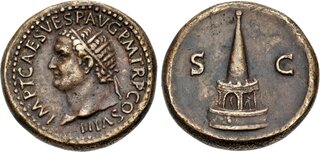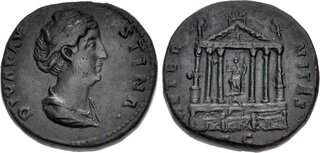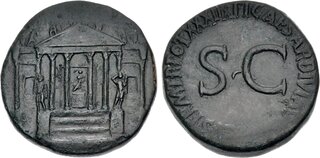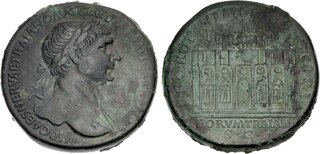Lot description:
Titus. AD 79-81. Æ Dupondius (28.5mm, 17.18 g, 6h). Rome mint. Struck AD 80-81 (or a 16th-17th century fantasy). IMP T CAES VESP AVG P M TR P COS VIII, radiate head left / Conical fountain set on plinth (Meta Sudans) with statues set within alternating squared and arched recesses, S C across field; LM in ink (old collector or museum initials) in upper left field. RIC II.1 205; BN III Faux Modernes 28; Asolati, M. Note sulla medaglia all'antica d'età rinascimentale tra invenzioni, rivisitazioni e "ritocchi" (Milano, 2018), pp. 155–6; Heenes and Jansen, Jacopo Strada's Magnum AC Novum Opus, A Sixteenth-Century Corpus Of Ancient Numismatics (Berlin, 2022), pp. 292, no. 5 (this coin illustrated). Yellow-brown surfaces, minor marks and scratches, tooled and smoothed. Good VF. An extreme rarity, the only specimen not in a museum collection. LOT SOLD AS IS, NO RETURNS – Not Suitable For Encapsulation.
The Meta Sudans was a tall fountain located in front of the Flavian Amphitheater, it marked the spot where processions would turn from the Via Trumphalis along the Palatine and onto the Roman Forum. It was erected shortly after the completion of the amphitheater, between AD 89-96.
This coin is not without controversy. The consignor showed photos of this coin to the late Ted Buttrey, curator at the Fitzwilliam Museum, in the mid 1990s who studied it intently. He concluded that the coin must be genuine and gave the following appraisal: "The two pieces, RIC 205 = L195A and [this] piece, were struck from the same obverse die, while Paris was struck from a very similar die by the same engraver, the way the wreath ends terminate at CO and OS respectively. However, the reverses were struck from three separate dies, distinguished by the nature and placing of the arches below the steeple. It is certainly beyond belief that an evil modern craftsman, attempting to create an un-struck type for Titus, would have - or even could have - stretched out his hand toward the mountains of random asses and dupondii still surviving, and come up with three pieces to work on which had been produced virtually at the same moment at the Rome mint amid the abundant bronze coinages of 80-81 AD. I think we have to accept it as genuinely ancient." More recently, the coin was studied in-hand by the current curator of the Coins and Medals department at the British Museum who commented that he had seen genuine Titus dupondii with similar surfaces and concave flans and since Ted Buttrey had said it was authentic, he had no reason to disagree. He did confirm that it had been tooled and smoothed in similar fashion as the BM and BN specimens.
In the years since Professor Buttrey's comments, further research has been done on this coin as well as others of its type. New evidence supports this being a Paduan-era medallion of the 16th-17th century schools in Italy. The Asolati and Heenes references cited above, one of which included this very coin, detail the works of Giovanni Cavino, Jacopo Strada, and other 16th century artists. Both authors believe that every extant specimen, including the BM coin, are Paduan-era medallions and that no genuine ancient coins of the type exist. It is interesting to note that the sestertius of this type has a laureate base instead of the statues seen here. Had an ancient celator carved the dies, we would expect to see a similar scene on both denominations. This lends credence to the belief that the Renaissance engravers had not actually seen the fountain they were engraving. A note from the consignor: "Dr. Heenes did not study my coin in hand when preparing his book, he only worked from a photo." Cataloger note: Since cataloging this coin for Triton, a new Paduan-era sestertius of Vitellius has been found, CNG E-551, lot 770. The reverses share unmistakable similarities; the alternating squared and arched recesses, the beaded edges around the enclosures, and the base style lead me to believe that both coins are the work of the same Renaissance engraver.
There are only five of this type known: one each in the British Museum, Bibliothèque National, Nationale di Venezia, Banca Regionale del Veneto, and the one offered here from a private collection. This coin is the only specimen available in the public market and has been in the consignor's collection for over 50 years.
Estimate: 1000 USD |  |










